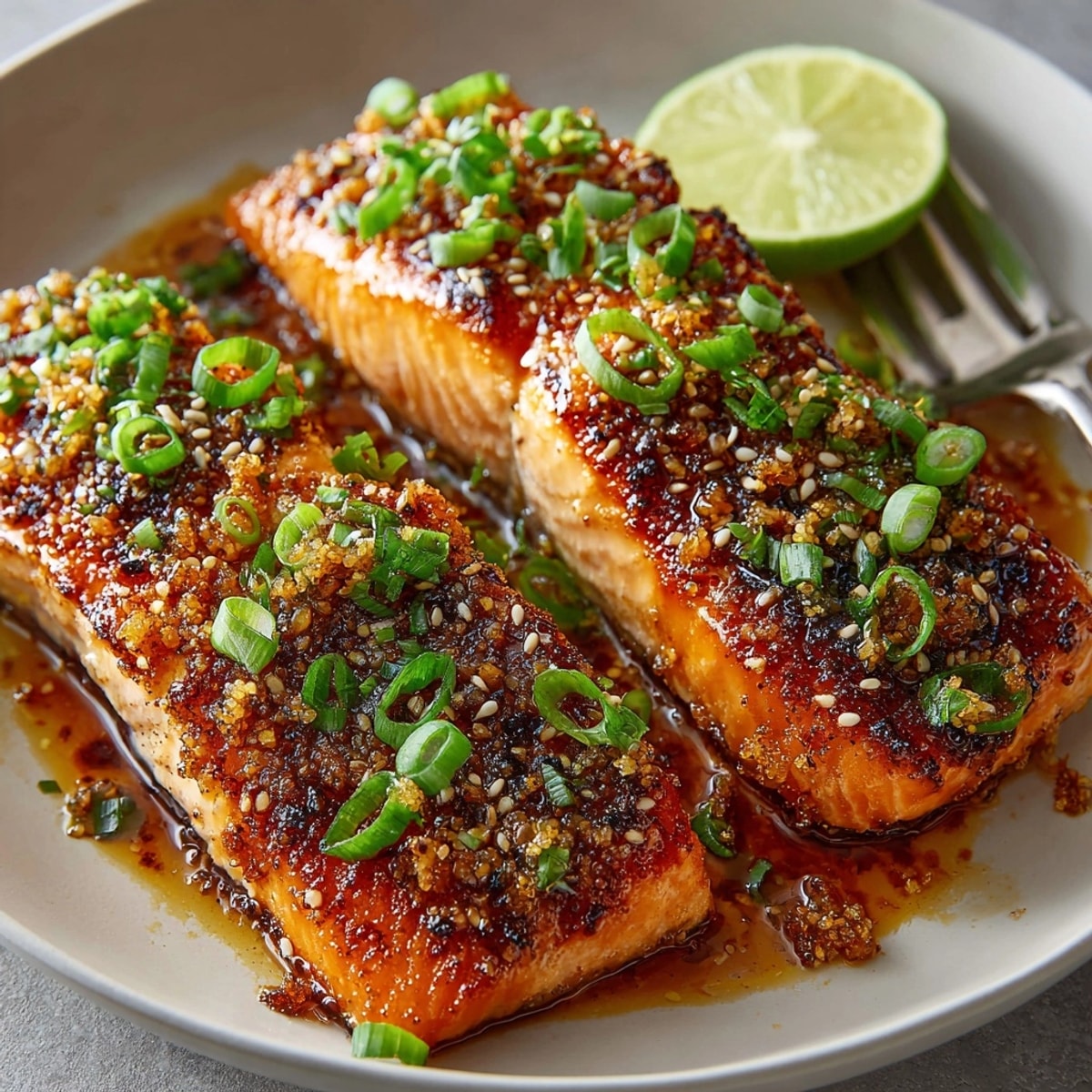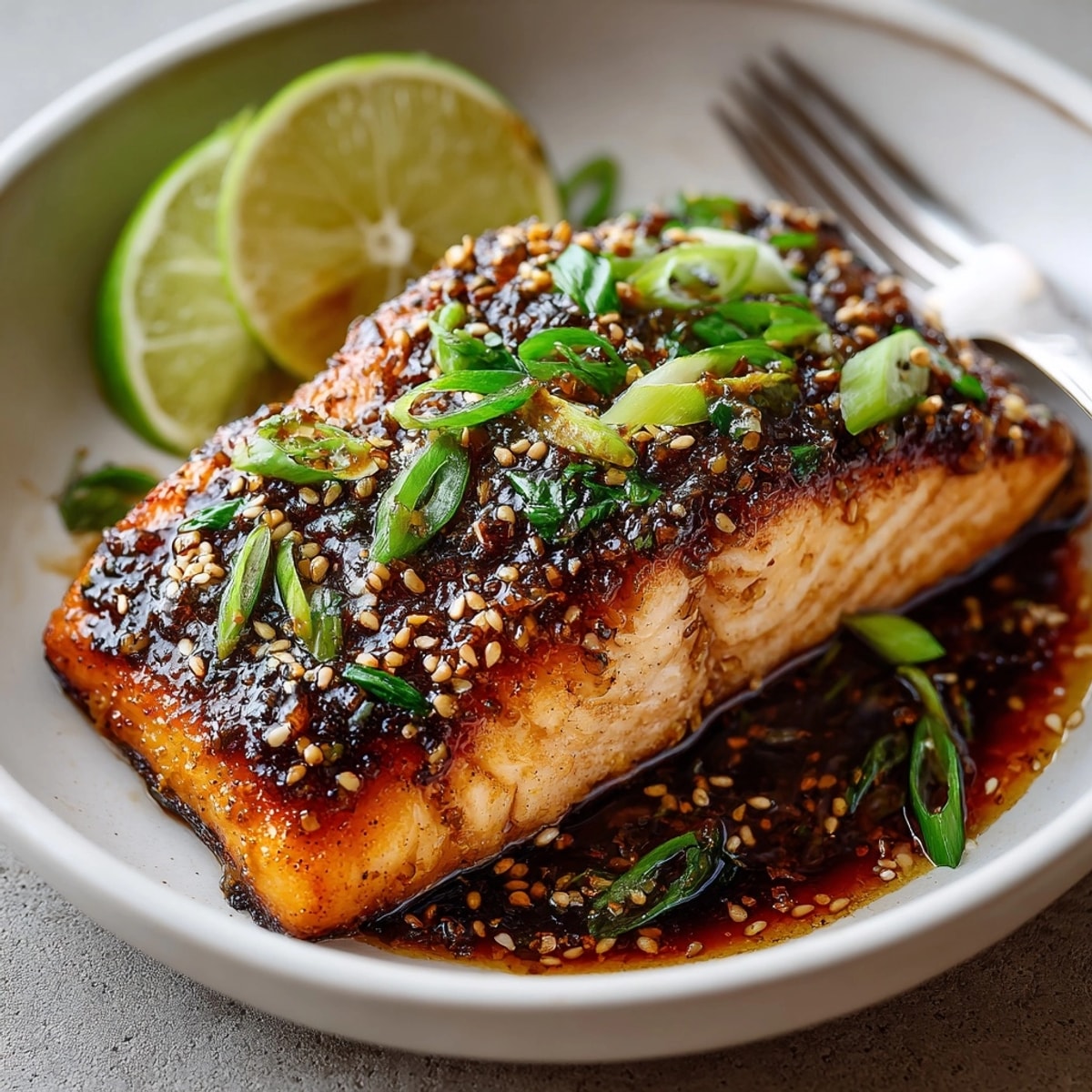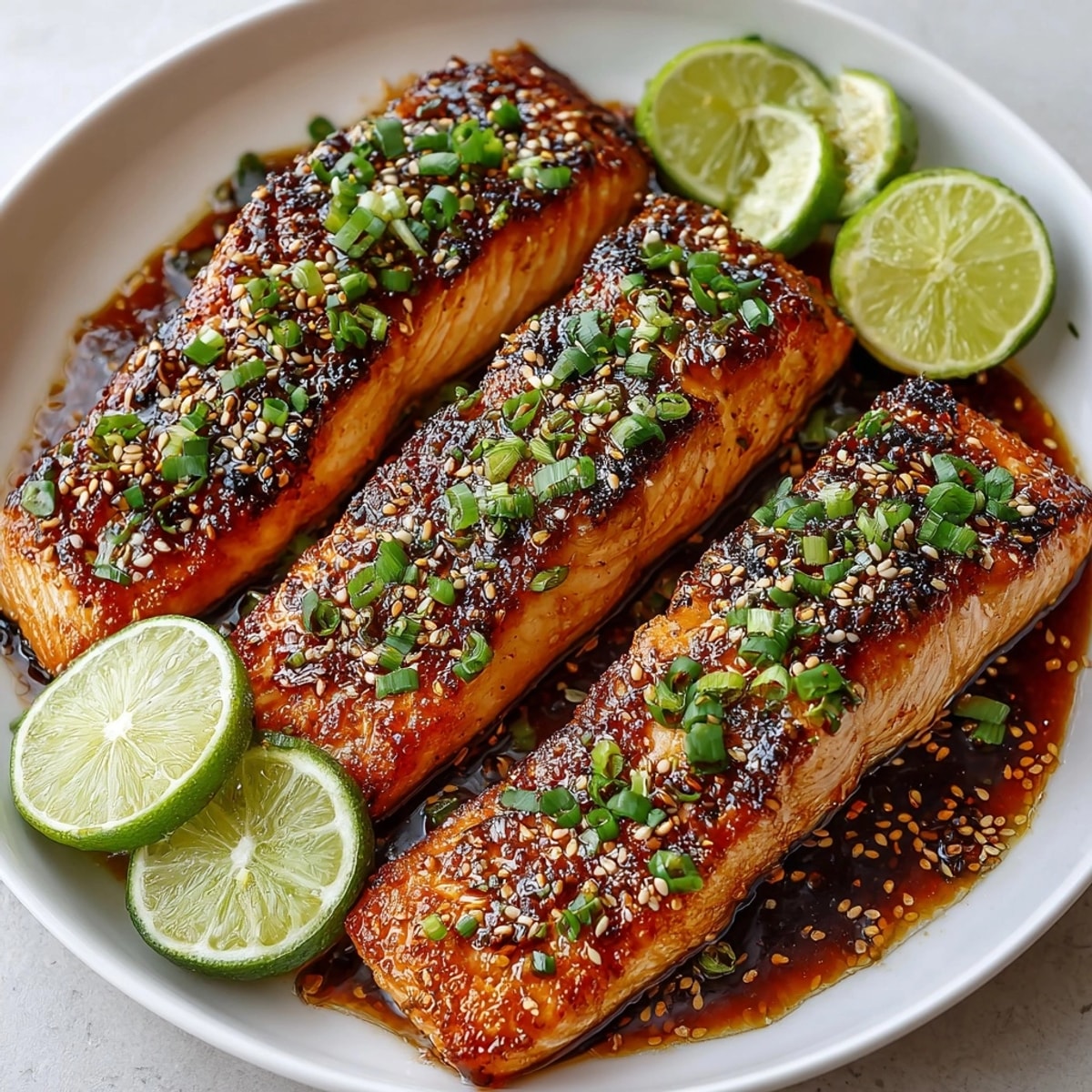 Save
Save This succulent ginger soy glazed salmon has become my weeknight dinner hero, combining the perfect balance of savory, sweet, and umami flavors in a dish that feels restaurant-worthy but comes together in just 25 minutes.
I first created this recipe when my mother in law unexpectedly announced she was coming for dinner. With just salmon in the fridge and a knob of ginger that needed using, this dish was born out of necessity but has since become our most requested family meal.
Ingredients
- For the Salmon: 4 salmon fillets 6 oz each choose wild caught when possible for better flavor and nutrition
- For the Salmon: 1/2 teaspoon kosher salt enhances the natural sweetness of the salmon
- For the Salmon: 1/4 teaspoon freshly ground black pepper adds gentle heat without overpowering
- For the Ginger Soy Glaze: 1/4 cup low sodium soy sauce provides the umami base without making the dish too salty
- For the Ginger Soy Glaze: 2 tablespoons honey creates caramelization and balances the saltiness
- For the Ginger Soy Glaze: 1 tablespoon freshly grated ginger the star ingredient that adds warmth and zing look for firm ginger with smooth skin
- For the Ginger Soy Glaze: 2 teaspoons sesame oil adds nutty depth that regular oils cannot provide
- For the Ginger Soy Glaze: 1 tablespoon rice vinegar brightens all flavors with subtle acidity
- For the Ginger Soy Glaze: 2 garlic cloves minced works with ginger to create aromatic foundation
- For the Ginger Soy Glaze: 1/2 teaspoon red pepper flakes optional adds gentle heat that builds slowly
- For the Ginger Soy Glaze: 1 tablespoon water helps create the perfect glaze consistency
- For the Ginger Soy Glaze: 2 teaspoons cornstarch thickens the glaze so it clings beautifully to the salmon
- For Garnish: 2 tablespoons sliced green onions adds fresh color and mild onion flavor
- For Garnish: 1 teaspoon toasted sesame seeds provides textural contrast and visual appeal
- For Garnish: Lime wedges optional the final bright note that cuts through richness
Instructions
- Prepare the Oven:
- Preheat your oven to 400°F. This moderate temperature ensures the salmon cooks through without drying out while allowing the glaze to caramelize perfectly. Line a baking sheet with parchment paper or foil for easy cleanup. The liner also prevents the delicate fish from sticking.
- Prepare the Salmon:
- Pat each salmon fillet thoroughly dry using paper towels. This crucial step ensures proper browning and helps the glaze adhere better. Season both sides generously with salt and pepper, making sure to distribute the seasoning evenly. Arrange the fillets on your prepared baking sheet with at least an inch between each piece to allow heat circulation.
- Create the Glaze Base:
- Combine soy sauce, honey, freshly grated ginger, sesame oil, rice vinegar, minced garlic, and red pepper flakes in a small saucepan. Place over medium heat and bring to a gentle simmer, stirring occasionally to help the honey dissolve completely. Allow the mixture to simmer for about 2 minutes to infuse the flavors and slightly reduce.
- Thicken the Glaze:
- In a small bowl, whisk together water and cornstarch until completely smooth with no lumps. This creates a slurry that will thicken your glaze without clumping. Pour this mixture into your simmering sauce while whisking constantly. Continue cooking for 1 to 2 minutes, stirring frequently as the sauce thickens to a glossy, coat the back of a spoon consistency. Remove from heat immediately to prevent over thickening.
- Apply First Glaze Layer:
- Using a pastry brush, generously coat each salmon fillet with half of the prepared glaze. Ensure even coverage, getting some of the glaze on the sides of the fillets as well. Reserve the remaining glaze for later use. This first application allows the flavors to begin penetrating the fish.
- Bake the Salmon:
- Place the glazed salmon in your preheated oven and bake for 10 to 12 minutes. The exact time depends on the thickness of your fillets. For perfect doneness, look for the salmon to be just barely opaque throughout and flaking slightly when tested with a fork. The internal temperature should reach 125°F for medium rare or 130°F for medium.
- Caramelize the Glaze:
- Switch your oven to broil setting. Carefully remove the salmon from the oven and brush the remaining glaze over each fillet, ensuring even coverage. Return to the oven, placing the baking sheet about 6 inches from the broiler. Broil for just 1 to 2 minutes, watching carefully to prevent burning. The glaze should bubble, thicken further, and develop a beautiful caramelized finish.
- Serve and Garnish:
- Transfer the glazed salmon fillets to serving plates while still hot. Sprinkle each portion with sliced green onions and toasted sesame seeds for color, flavor, and texture. Add lime wedges on the side for diners to squeeze over their salmon just before eating. The acid from the lime brightens the rich flavors and cuts through the sweetness.
 Save
Save The fresh ginger is truly the magical ingredient in this recipe. I discovered its transformative power when I accidentally doubled the amount one evening. Rather than ruining the dish, it created this incredible aromatic quality that elevated the entire meal. Now I always keep fresh ginger in my freezer it grates more easily when frozen and lasts for months.
Perfect Pairings
This ginger glazed salmon pairs beautifully with simple side dishes that complement without competing with its bold flavors. Steamed jasmine rice makes an ideal base, soaking up any extra glaze that runs off the salmon. For vegetables, try quick sautéed bok choy with garlic or steamed broccoli finished with a squeeze of lemon. The lightness of these sides balances the richness of the glazed salmon.
For a complete Asian inspired meal, consider starting with a simple miso soup and ending with fresh fruit like mango or lychee. If serving wine, a slightly off dry Riesling or Gewürztraminer provides the perfect balance to the sweet and savory glaze.
Storage and Reheating
Leftover salmon will keep in an airtight container in the refrigerator for up to 2 days. For best results when reheating, place in a 275°F oven covered with foil until just warmed through, about 10 minutes. This gentle reheating prevents the salmon from drying out or developing that strong fishy flavor that can happen with microwaved seafood.
The glaze itself can be made up to 5 days ahead and stored separately in the refrigerator. Simply reheat gently before using. This make ahead option is perfect for busy weeknights when you need dinner on the table quickly.
Ingredient Substitutions
No fresh ginger available? In a pinch, substitute 1 teaspoon ground ginger, though the flavor will be less vibrant.
Maple syrup or brown sugar can replace honey for a slightly different flavor profile.
White wine vinegar or apple cider vinegar work well in place of rice vinegar.
For a soy free version, use coconut aminos instead of soy sauce, reducing the honey slightly as coconut aminos are naturally sweeter.
Salmon can be substituted with other firm fish like arctic char or steelhead trout with similar cooking times.
Seasonal Adaptations
In Winter add 1/2 teaspoon Chinese five spice to the glaze for warming depth. Serve with roasted root vegetables instead of rice for a heartier meal. Increase red pepper flakes for more internal warmth.
For Spring add 1 tablespoon orange zest to brighten the glaze. Serve over a bed of spring pea puree for seasonal freshness. Garnish with fresh herbs like cilantro or mint instead of green onions.
For Summer grill the salmon outdoors instead of using the oven. Add 1 tablespoon minced lemongrass to the glaze for brightness. Serve with a cold cucumber salad dressed with rice vinegar and sesame.
 Save
Save Enjoy this delicious and easy ginger soy glazed salmon!
Recipe Questions & Answers
- → How do I prevent the salmon from overcooking?
Check the salmon for flakiness at the thickest part after 10 minutes. It should easily flake with a fork and look opaque.
- → Can I use frozen salmon fillets?
Yes, thaw frozen fillets overnight in the fridge and pat dry before glazing and roasting for the best texture.
- → What can I serve with this main dish?
Steamed jasmine rice, sautéed bok choy, or roasted vegetables make excellent side options to complement the flavors.
- → Is it possible to make this dish gluten-free?
Absolutely. Simply substitute tamari for soy sauce and ensure all other ingredients are gluten-free certified.
- → How spicy is the glaze?
The glaze is mildly spicy if red pepper flakes are added, but you can omit them or add sriracha for extra heat.